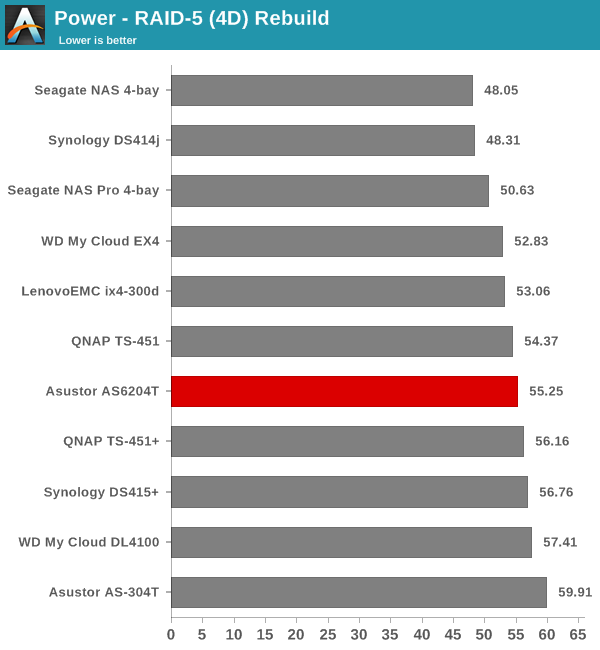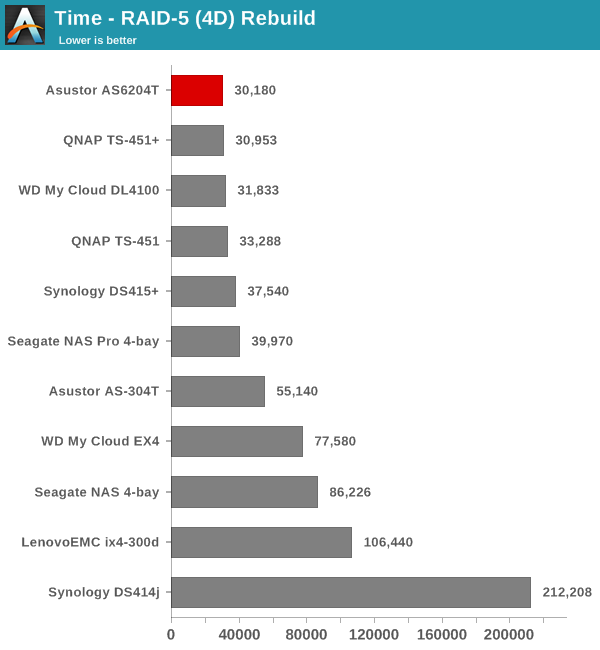Asustor AS6204T Braswell NAS Review
by Ganesh T S on November 5, 2015 8:00 AM ESTMiscellaneous Aspects and Final Words
In order to keep testing consistent across all 4-bay units, we performed all our expansion / rebuild testing as well as power consumption evaluation with the unit configured in RAID-5. The disks used for benchmarking (Western Digital WD4000FYYZ) were also used in this section. The table below presents the average power consumption of the unit as well as time taken for various RAID-related activities. In the general state with the hard disk powered on, but not actively reading or writing data, the power consumption was around 47 W, though it dropped to around 14 W with the disks in sleep mode.
| Asustor AS6204T RAID Expansion and Rebuild / Power Consumption | ||
| Activity | Duration (HH:MM:SS) | Avg. Power (W) |
| Single Disk Init | - | 19.94 W |
| JBOD to RAID-1 Migration | 08:08:00 | 31.27 W |
| RAID-1 (2D) to RAID-5 (3D) Migration | 17:31:00 | 43.65 W |
| RAID-5 (3D) to RAID-5 (4D) Expansion | 18:50:00 | 54.53 W |
| RAID-5 (4D) Rebuild | 08:23:00 | 55.25 W |
The graphs below show the power consumption and rebuild duration when repairing a RAID-5 volume for the various 4-bay NAS units that have been evaluated before.


The Asustor AS6204T is not the most power-efficient NAS around. The ARM-based 4-bay NAS units perform better in that respect. However, Asustor continues to have the shortest rebuild duration for a RAID-5 volume among all the 4-bay NAS units that we have tested before.
Concluding Remarks
Asustor became the first vendor to bring a Braswell-based NAS to the market with the AS6xxx series. The capabilities of the unit make it ideal for power users, SOHOs and SMBs. Since the AS6204T is based on the latest Braswell platform and uses the quad-core Celeron N3150, there is a slight pricing premium over the other 4-bay NAS units based on Intel platforms. With a street price of $670, it is approximately in the same ballpark as the recently reviewed QNAP TS-451+.
Asustor's ADM OS (v2.5 was used in our review) has been receiving numerous fixes and feature additions over the last year. One of the things that I like about Asustor is their prompt attention to feedback and bug reports, as well as speedy resolution of reported issues. Asustor knows that they have a lot of catching up to do in terms of OS features and performance. However, it is good from a consumer viewpoint that they are taking all efforts to bridge that gap as soon as possible.
Coming to the performance aspects, we find that CIFS read performance is very good, while write performance could definitely do with some improvements. NFS support, on the other hand, leaves a lot to be desired (both in terms of performance as well as supported features such as server side locks). The good aspect is that a beta release with a few fixes is already in our hands. The fixes will be migrating to a stable release shortly.
The AS6204T also comes with a HDMI 1.4b port and bundled media playing apps. The NAS can also be used as a media player for 4K videos with support for multi-channel audio over SPDIF as well as HDMI. The presence of AES-NI enables powerful encryption capabilities at a reasonable price point. The unit ships with 4GB of RAM, but users can upgrade easily to 8GB (the unit has two SO-DIMM slots). This could be important if a lot of apps end up running on the NAS simultaneously. Unlike competitors who provide a 2-year warranty for this class of products, Asustor advertises a 3-year warranty for the AS6204T.
Coming to the business end of the review, Asustor's top-end Braswell NAS is power efficient, extensible and performs in an acceptable manner. There is obviously scope for improvement on the software side - both in terms of performance as well as feature set. However, having observed the evolution of ADM over the last couple of years and the commitment shown by Asustor, I can say that they are on the right track.











29 Comments
View All Comments
RdVi - Thursday, November 5, 2015 - link
It's hard to compare the graphs on page 4 when the values on the axis vary (sometimes wildly) between the two. Flicking back and forth it is very hard to easily compare on face value. Would it not be possible to have the scale locked to whichever graph approaches the highest value?ganeshts - Thursday, November 5, 2015 - link
The issue here is that these graphs are generated on a per-review basis - i.e, the graph that you see for the QNAP TS-451+ was generated at the time of writing the QNAP TS-451+ review. At that time, the Asustor AS6204T hadn't been evaluated, so it is not possible to know ahead of time what the highest value is going to be.I think we have the best possible solution here in the timeframe that can be devoted to the review - the other solution is to simply not have any graphs for the competing units (similar to what we did for the QNAP TS-451+ review which was the first 4-bay one done with the new methodology).
DanNeely - Friday, November 6, 2015 - link
Are the graphs coming from the bench software itself? If there is a CSV export option generating combined comparison graphs (or rescaled stand alone ones) shouldn't be hard to do after the fact.ganeshts - Friday, November 6, 2015 - link
The bench software is written by me :) (except for the core trace replay component which is compiled from NASPT source). And, yes, the graphs are generated at the end of each benchmark run by my code.I don't have a CSV export option in the software yet, as I only export the HTML tables that are linked above each graph. So, yes, the data is there, but not in a format suitable for reprocessing with each new NAS run.
It is possible to implement CSV export and graph regeneration, but it is a matter of how much time I can spend to get the new code up and running. At this moment, I think the time cost far outweighs the benefits provided. I am currently working on optimizing our SPEC SFS testbed and benchmarking - I think that will provide more benefits to readers in the long run.
Oyster - Friday, November 6, 2015 - link
Ganesh, I mentioned this in some of your other NAS reviews. You need to review the software side of these vendors now. Would be awesome to see the biggies go head to head... Synology, QNAP, ASUS, and Lenovo. Please try to cover app offerings to other items like backdooring via SSH, etc.As usual, keep up the good work.
ganeshts - Friday, November 6, 2015 - link
Yes, it is in the works. The problem is that these are 'subjective' aspects and require more effort to use and record observations compared to objective benchmarking.MrElectrifyer - Saturday, November 7, 2015 - link
Curious how this compares to a QNAP TS-470 Pro...MrElectrifyer - Saturday, November 7, 2015 - link
So far, I know the TS-470 Pro can support more than 8GB of RAM...I upgraded mine to 10GB.WatcherCK - Monday, November 9, 2015 - link
Looks like disks get formatted internally to Ext4... The full specifications link seems to point back to the articles initial page was this by design? The full spec pdf for this NAS can be found here: http://www.asustor.com/service/resource?type=3&... (for a laugh check out what the display on the NAS is saying on its Asustor page, what do you know Asus? :) )Anyone considering a DIY NAS should checkout the new Asrock Rack C236 WSI that combined with a Silverstone DS380 would make for a powerful little storage box/virtualization server... They dont seem to be available anywhere yet unfortunately and Supermicro only have MATX C236 motherboards.